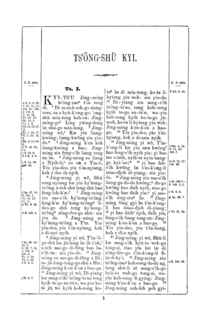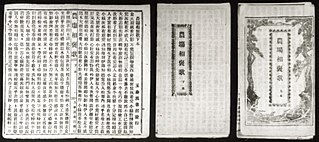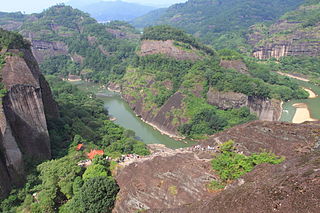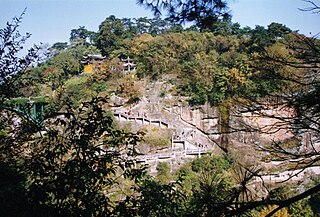
Yongkang, formerly known as Lizhou, is a county-level city located in the central part of Zhejiang province, in the People's Republic of China. It is southeast of the Jinhua City boundary and approximately 180 km from Hangzhou. It has an area of 1,049 km2 (405 sq mi) and a population of 536,000, including more than 100,000 non-resident workers. According to a 2010 census, its metro area of Yongkang City and Wuyi County was home to 1,073,389 inhabitants. Yongkang is known as the "hardware capital of China."
The Fāngyán, compiled by the Han dynasty poet and philosopher Yang Xiong, was the first Chinese dictionary of regionalisms. Translations of this ancient dictionary's title include: 'regional words', 'regional expressions', 'dictionary of local expressions', and 'regional spoken words'.
Changsha dialect is a dialect of New Xiang Chinese. It is spoken predominantly in Changsha, the capital of Hunan province. It is not mutually intelligible with Standard Mandarin, the official language of China.

The Ningbo dialect is a dialect of Wu Chinese, one subdivision of Chinese language. Ningbo dialect is spoken throughout Ningbo and Zhoushan prefectures, in Zhejiang province.

Dongyangosaurus is a genus of saltasaurid sauropod dinosaur from the early Late Cretaceous. The only species is Dongyangosaurus sinensis, from which only a single fragmentary skeleton is known, coming from the Zhejiang province of eastern China. It was described and named by Lü Junchang and colleagues Like other sauropods, Dongyangosaurus would have been a large quadrupedal herbivore.

Wenling is a coastal county-level city in the municipal region of Taizhou, in southeastern Zhejiang province, China. It borders Luqiao and Huangyan to the north, Yuhuan to the south, Yueqing to the west, looks out to the East China Sea to the east. Wenling locates on 28°22'N, 121°21'E, approximately 300 km (190 mi) south of Shanghai.

Bbánlám Hōng'ggián Pìngyīm Hōng'àn, Bbánlám pìngyīm, Minnan pinyin or simply pingyim, is a romanization system for Hokkien Southern Min, in particular the Amoy (Xiamen) version of this language.

The Danxia landform refers to various landscapes found in southeast, southwest and northwest China that "consist of a red bed characterized by steep cliffs". It is a unique type of petrographic geomorphology found in China. Danxia landform is formed from red-coloured sandstones and conglomerates of largely Cretaceous age. The landforms look very much like karst topography that forms in areas underlain by limestones, but since the rocks that form danxia are sandstones and conglomerates, they have been called "pseudo-karst" landforms. They were formed by endogenous forces and exogenous forces.
Small Flowery Miao is a Miao language of China spoken by the Gha-Mu people, that is closely related to Hmong: Hmong and Small Flowery Miao are listed as the first and second local dialects of the Chuanqiandian Cluster of West Hmongic languages. It is spoken in Nayong, Shuicheng, Zhenning, Guanling, and Hezhang counties of western Guizhou, China.

Northern Min, is a group of mutually intelligible Min varieties spoken in Nanping prefecture of northwestern Fujian.
Yueosaurus is an extinct genus of basal ornithopod dinosaur known from Zhejiang Province, China.
The Shaoxing dialect is a Wu dialect spoken in the city of Shaoxing more specifically in the city center of Yuecheng and its surrounding areas. It is a representative Wu dialect with a tripartite distinction on voiced stop initials and a textbook register split with each of the four tonal categories of Middle Chinese being divided into upper and lower registers. Within Wu, it is classified as a Northern Wu dialect belonging to the Taihu division within which it is classified under the Linshao subdivision (臨紹小片/临绍小片).
Mai is a variety of Chinese of uncertain affiliation spoken in the area of 崖县 Yáxiàn (Sanya) in southern Hainan, China. It was classified as Yue in the Language Atlas of China, but that is no longer certain. There are about 15,000 speakers of Maihua in southern Hainan.
Dongyangopelta is an extinct genus of nodosaurid ankylosaurian dinosaur known from the "middle" Cretaceous Chaochuan Formation of Dongyang, Zhejiang Province, China. Dongyangopelta was first named by Rongjun Chen, Wenjie Zheng, Yoichi Azuma, Masateru Shibata, Tianliang Lou, Qiang Jin and Xingsheng Jin in 2013 and the type species is Dongyangopelta yangyanensis. It differs from Zhejiangosaurus, the second nodosaurid from southeast China, in the characters of presacral rod, ilium, and femur. Donyangopelta is distinguishable from Zhejiangosaurus only on the basis of the morphology of its pelvic shield.
Li Rong was a Chinese linguist known for his work on Chinese dialectology. He was director of the Institute of Linguistics at the Chinese Academy of Social Sciences from 1982 to 1985, and editor of the Language Atlas of China and the Great Dictionary of Modern Chinese Dialects.
Independent Division of Anhui Provincial Military District (1st Formation) was formed in December 1964 from the 540th Infantry Regiment and 560th Artillery Regiment of the disbanding 180th Army Division. The division was then composed of 3 infantry regiments.
Independent Division of Zhejiang Provincial Military District (1st Formation) was formed in December 1964 from the assets of 82nd Garrison Regiment of the inactivating 16th Garrison Division and 92nd Garrison Regiment.
In Chinese dialectology, Beijing Mandarin refers to a major branch of Mandarin Chinese recognized by the Language Atlas of China, encompassing a number of dialects spoken in areas of Beijing, Hebei, Inner Mongolia, Liaoning and Tianjin, the most important of which is the Beijing dialect, which provides the phonological basis for Standard Chinese.
The Fangyan Formation is a geologic formation in China (Dongyang). It is made up of mainly conglomerates. It preserves dinosaur fossils dating back to the Late Cretaceous.

Fangyan is a town under the administration of Yongkang, Zhejiang, China. As of 2020, it administers the following two residential neighborhoods and 24 villages:







